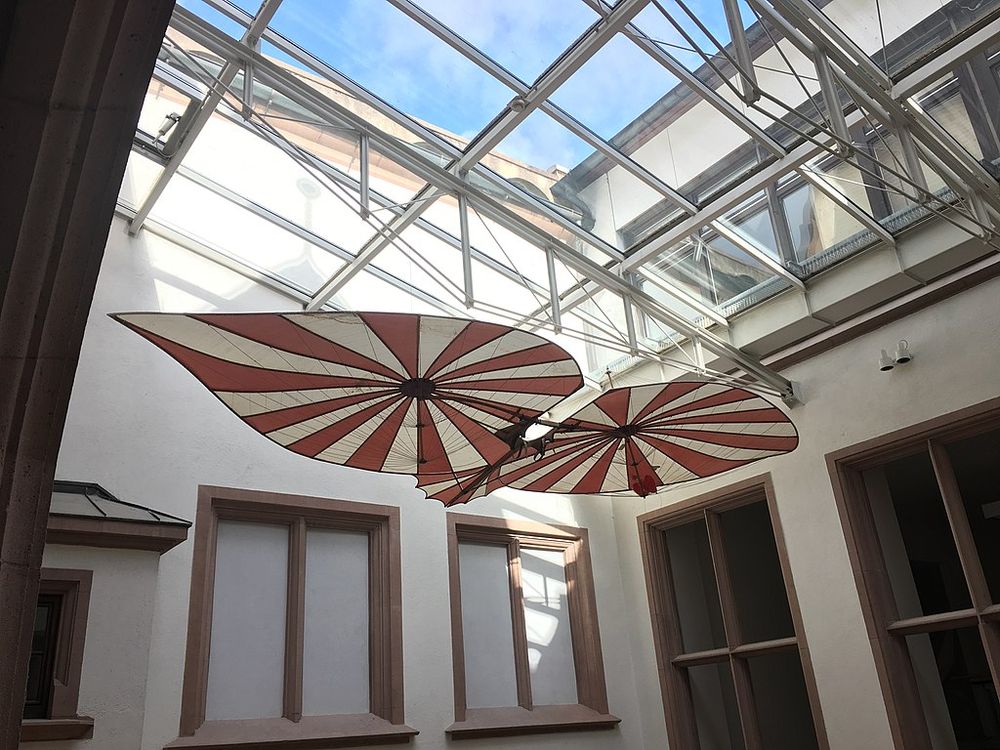Albrecht Berblinger was an early aviation pioneer who is best known for designing a hang glider, nearly four decades before British inventor George Cayley sent his butler flying 900 feet across a Brompton dale. However, unlike George Cayley and dozens of aviation enthusiasts before and after him, Berblinger wasn’t successful in his demonstration. Instead, he splashed into the Danube river and the failure practically destroyed his career.
Albrecht Berblinger was born in 1770 in Ulm, Germany, to a poor family. His father worked in the armory of the Free Imperial City of Ulm, and through him, young Berblinger came into contact with all kinds of mechanical equipment. When he was 13, Berblinger’s father died and he was sent to an orphanage. There, he was forced to start an apprenticeship as a tailor. Berblinger excelled in his craft, becoming a master tailor at the age of 21. But his passion was mechanics.

An old postcard depicting Albrecht Berblinger’s failed attempt to fly. Photo: Wikimedia
In 1808, when a soldier lost a leg, Berblinger built him a prosthesis with a movable knee joint. The doctors at the city hospital were impressed by this invention, and in 1809 Berblinger asked the Bavarian king for a patent. But his request was rejected. The setback did not discourage Berblinger. Instead, he devoted himself to the boldest of all schemes—to fly in the air.
Berblinger began developing a flying machine despite mocking he received from the people, and threats to expel him from the guild of tailors. He ignored these threats and put all of his income into the process, and continued to build his craft, eventually designing a hang glider capable of short flights. He secretly carried out his flight experiments in the vineyards on the Michelsberg in Ulm, using the vineyard walls and cottages as his launch points. Even Frederick I of Württemberg began to show interest in his efforts and proposed to support the inventor financially provided he was able to demonstrate the functionality of his glider.

Albrecht Berblinger’s glider.
Originally, Berblinger intended to jump off the Ulm Minster’s roof, which was about 100 m high back then. But Berblinger’s flying abilities were called into question, and it was decided that Berblinger will jump off a wall near the Danube river instead.
On May 30, 1811, Berblinger appeared on the banks of the Danube. The bulwark of the city wall towered 13 meters over the bank. On top of this bastion a seven meter high wooden scaffold had been erected. So Berblinger stood 20 meters above the Danube. The other bank of the Danube was 40 meters away, that's where he was supposed to land. The hang glider, which he designed and built himself, was attached to his back and arms. People crowded on both banks of the river and waited for the sensation. Among the crowd was the king, his three sons, and the crown prince of Bavaria. But Berblinger hesitated. He claimed that his hang glider broke and called off the flight, but it was most likely because he didn’t find the wind conditions favorable. The spectators rumored that Berblinger developed cold feet and turned white as a brick of cheese.

Memorial stone at Eagles Bastion, the place from where Berblinger attempted his jump. Photo: Eigenes Werk/Wikimedia
Berblinger arrived again the next day for another attempt. The King had already left town for some work, but his brother, Duke Henry, and the princes stayed behind to watch Berblinger fly. However, the wind conditions had not improved from the previous day, and Berblinger kept delaying his jump. The crowd was getting annoyed and urged him to finally start his performance. Eventually, after hours of delay, an impatient policeman allegedly gave the aviator a push, which sent him falling to the river below.
Berblinger was rescued by the fishermen and the crowd booed. The city never forgave his failure. He was called a liar and a cheater, and this affected his professional reputation as well, and customers stopped coming to his tailor’s workshop. He died penniless at the age of 58, and was buried in a pauper's grave.

It was only in the 20th century that the world began to appreciate Berblinger’s efforts. It was shown that the aviation pioneer had chosen the most unfavorable place imaginable to launch his flight, since the cool temperature of the river produces a downdraft even in the warmest weather, making it quite difficult to generate enough lift for a sustained flight. Furthermore, researchers demonstrated in 1986 that there was nothing wrong in Berblinger’s design and the glider actually was able to fly.
The same year, on the occasion of the 175th anniversary of the first flight attempt, the city of Ulm organized a flight competition to find out whether it would have been possible to cross the Danube at this point. Even with all modern lightweight materials like carbon and fiberglass, aluminum and polyurethane foam, of the 30 competitors who took part, 29 fell into the Danube. The only one who made it to the other bank suffered a dislocated arm as he landed.
Today, a replica of the Berblinger’s flying machine can be seen in the stairwell of the Ulm City Hall.

A replica of Berblinger’s glider at Ulm City Hall. Photo: Eigenes Werk/Wikimedia
References:
# Tabea Tietz, “Albrecht Berblinger, the Tailor of Ulm and His Flying Machine”, SciHi Blog
# Johannes Schweikle, “Schneiderlein im Sturzwind”, Spiegel












Comments
Post a Comment